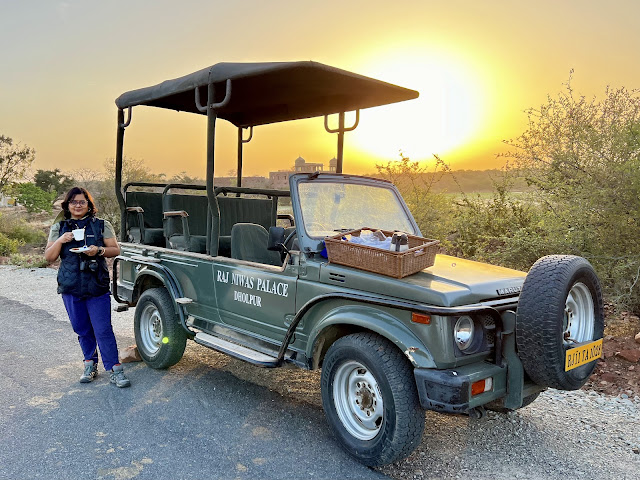 |
| The Talab-e-Shahi and Khanpur Mahal. Image by: Oishimaya Sen Nag |
There is royalty in its name - Talab-e-Shahi, meaning the royal pond. It is, however, not exactly a pond but a lake that was artificially created along with the Khanpur Mahal on its shores in 1617 to serve the Mughal Emperor Shah Jahan during his hunting trips to Dholpur. Today, the lake lies around 27 km from the town of Dholpur in Rajasthan.
I never knew about its existence until my visit to the Raj Niwas Palace in Dholpur, Rajasthan, to explore the wildlife of the nearby Chambal River. I was staying at the palace, a grand accommodation indeed, a heritage hotel owned by the former ruling family of the region with a rich history. I had booked a jeep safari at Raj Niwas for sightseeing in and around Dholpur. It was on the safari itinerary that I first came to learn about the Talab-e-Shahi.
 |
| Having the morning cup of tea at Van Vihar Sanctuary in the safari jeep of Raj Niwas Palace. |
We started from the palace early morning at 6 am to avoid the heat of the day as we were travelling in an open jeep. As we passed through the busy Dholpur town, we could see all the gazes upon us. Such open jeep vehicles are not commonly seen, and hence, it raised people's curiosity. Our first stop was at the Van Vihar Sanctuary, an offbeat wildlife destination that I will describe in a later post. From Van Vihar, we set off for Talab-e-Shahi.
Our jeep speeded through an interesting landscape of wheat fields interspersed with grasslands and scrub forests. It was brown and arid but had a raw beauty to it. Soon, we got to see an expanse of blue on the horizon with a beautiful red-coloured palatial building in the background. "Welcome to the Talab-e-Shahi and Khanpur Mahal," our guide greeted us.
As our jeep passed by the shores of the lake, I got quite excited. Many species of birds could be seen dotting the waters of this shallow lake. If this was the scene in early summer as we were travelling in the first week of April, I could well imagine how this lake would be a paradise for the migratory birds and bird lovers in the winter. Tufted ducks, common teals, and pintails are among them.
I swung my camera into action, asking the driver to stop wherever there was a photo opportunity. The lake itself had a beauty to it that was enhanced by the historical ruins bordering it.
 |
| Painted storks in Talab-e-Shahi. Image by: Oishimaya Sen Nag. |
The Khanpur Mahal, however, was a bit disappointing. Not the palace itself but the way the local government had allowed it to fall into ruins really saddened me. It had been created as the pleasure residence of Shah Jahan during his visits to Dholpur for hunting. The architecture was grand but crumbling.
There was a beautiful garden through which you could walk to reach the lake's shores and enjoy seeing birds in it. I was overjoyed to see two pied kingfishers with their unique black and white plumage and crest on a ledge beside me. One of them flew up and started hovering over the lake before diving in to catch a fish. It failed to get one, but it would try again. Wishing it good luck, I moved on.
 |
| A pair of pied kingfishers on a ledge along the Talab-e-Shahi. Image by: Oishimaya Sen Nag |
I rode the jeep again, moving along the length of the lake and the wetlands on the other side of the road. I managed to photograph a great variety of birds. The grey-headed swamphens looked particularly striking in the wetlands, their bluish-purple plumage glistening in the sunlight and their red bill and forehead shield making a great contrast.
 |
| A grey-headed swamphen in the wetland. Image by: Oishimaya Sen Nag |
The sun was about to set, and the lake's sparkling clean waters, dotted by the silhouettes of many birds, appeared magical.
On my way back, I really wished that the concerned authorities would assign more care to this beautiful heritage destination. It would be a shame if we lost such gorgeous architecture due to mere negligence. I hope to return one day to see the Khanpur Mahal and the Talab-e-Shahi restored to the royal glory that they deserve.
Written by: Dr. Oishimaya Sen Nag
No comments:
Post a Comment